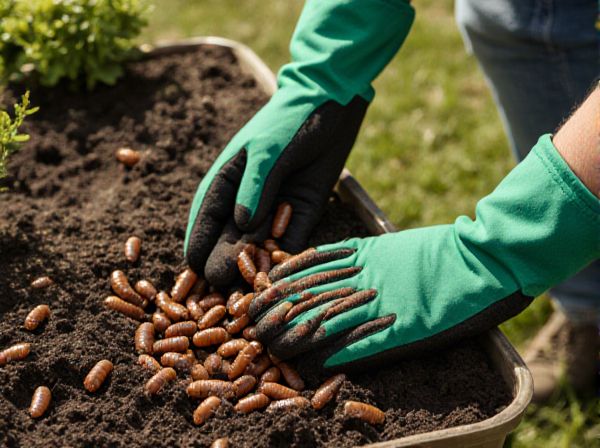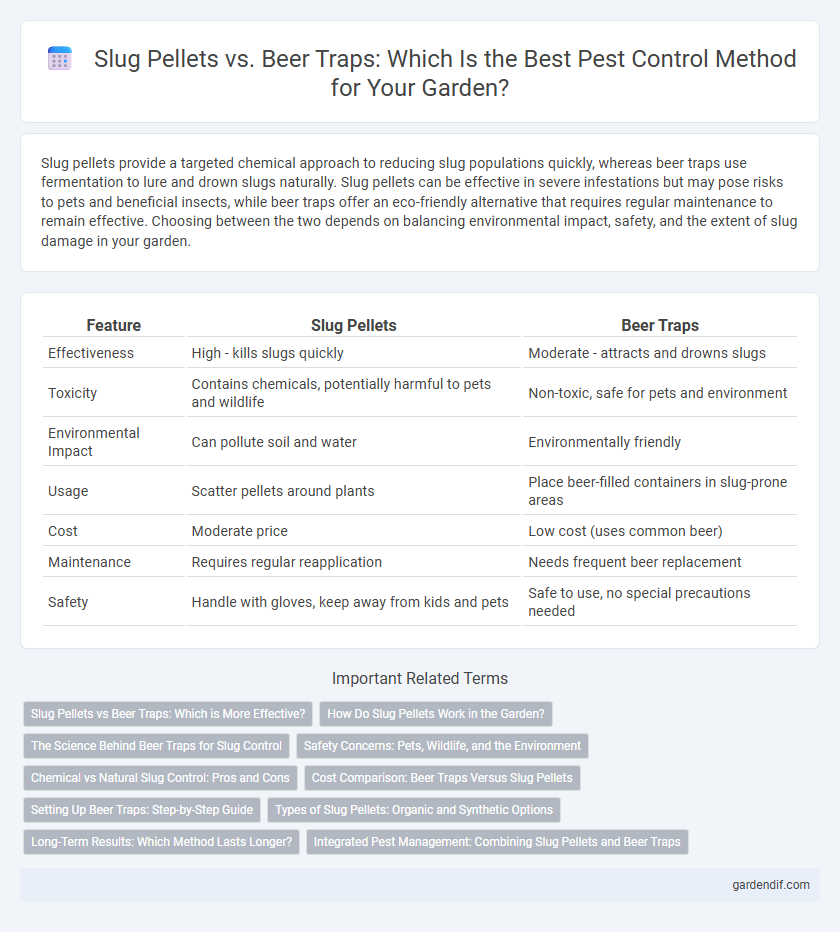
Slug pellets vs beer traps Illustration
Slug pellets provide a targeted chemical approach to reducing slug populations quickly, whereas beer traps use fermentation to lure and drown slugs naturally. Slug pellets can be effective in severe infestations but may pose risks to pets and beneficial insects, while beer traps offer an eco-friendly alternative that requires regular maintenance to remain effective. Choosing between the two depends on balancing environmental impact, safety, and the extent of slug damage in your garden.
Table of Comparison
| Feature | Slug Pellets | Beer Traps |
|---|---|---|
| Effectiveness | High - kills slugs quickly | Moderate - attracts and drowns slugs |
| Toxicity | Contains chemicals, potentially harmful to pets and wildlife | Non-toxic, safe for pets and environment |
| Environmental Impact | Can pollute soil and water | Environmentally friendly |
| Usage | Scatter pellets around plants | Place beer-filled containers in slug-prone areas |
| Cost | Moderate price | Low cost (uses common beer) |
| Maintenance | Requires regular reapplication | Needs frequent beer replacement |
| Safety | Handle with gloves, keep away from kids and pets | Safe to use, no special precautions needed |
Slug Pellets vs Beer Traps: Which is More Effective?
Slug pellets contain metaldehyde or iron phosphate, providing a quick and targeted way to reduce slug populations by poisoning them directly. Beer traps lure slugs through fermentation scent, drowning them in liquid, but require frequent maintenance and effectiveness varies with weather. Choosing between slug pellets and beer traps depends on the level of infestation and environmental safety concerns, with pellets offering faster results and beer traps serving as a chemical-free alternative.
How Do Slug Pellets Work in the Garden?
Slug pellets work by releasing active ingredients such as metaldehyde or iron phosphate, which are toxic to slugs when ingested, disrupting their nervous system and causing dehydration. These pellets are scattered around vulnerable plants, creating a barrier that encourages slugs to consume the bait instead of garden foliage. Unlike beer traps that attract slugs with fermentation, pellets provide a targeted chemical control method, minimizing collateral damage to beneficial insects.
The Science Behind Beer Traps for Slug Control
Beer traps attract slugs using fermentation byproducts like ethanol and CO2 that mimic natural food sources, effectively luring them into the liquid where they drown. The yeast fermentation process creates volatile compounds that slugs find irresistible, increasing trap efficiency compared to many commercial pellets. This method provides an eco-friendly alternative to chemical slug pellets by exploiting slug behavior and sensory biology for targeted pest control.
Safety Concerns: Pets, Wildlife, and the Environment
Slug pellets often contain metaldehyde or iron phosphate, which can be toxic to pets, wildlife, and beneficial insects if ingested, posing significant safety concerns. Beer traps, although less toxic, can attract non-target creatures such as amphibians and small mammals, potentially causing unintended harm or drowning. Opting for pet-safe pellets or organic slug control methods minimizes environmental impact and reduces risks to pets and wildlife habitats.
Chemical vs Natural Slug Control: Pros and Cons
Slug pellets, containing chemicals like metaldehyde or iron phosphate, provide fast and effective slug control but may pose risks to pets, wildlife, and the environment due to their toxicity. Beer traps act as a natural slug control method by attracting slugs with fermentation scents, reducing slug populations without harmful chemicals, but they often require frequent refilling and may not capture all pests. Choosing between chemical slug pellets and beer traps depends on prioritizing immediate pest reduction versus eco-friendly, sustainable slug management.
Cost Comparison: Beer Traps Versus Slug Pellets
Beer traps for slug control typically cost less upfront, using common household ingredients like beer, whereas slug pellets require purchasing chemical products that can be more expensive per application. Over time, slug pellets may incur higher costs due to repeated use and potential environmental disposal fees. Beer traps offer a cost-effective, eco-friendly alternative with lower ongoing expenses despite needing regular maintenance and beer replacement.
Setting Up Beer Traps: Step-by-Step Guide
To set up effective beer traps for slugs, begin by selecting shallow containers and burying them up to the rim in the soil near slug-prone plants. Pour fresh beer into each container until it is about halfway full, as the yeast and fermentation attract and drown the slugs. Replace the beer every few days to maintain trap potency and monitor slug activity regularly for optimal pest control results.
Types of Slug Pellets: Organic and Synthetic Options
Slug pellets are available in organic and synthetic formulations, each offering distinct pest control benefits tailored to specific garden needs. Organic slug pellets typically contain iron phosphate or ferric sodium EDTA, which are safer for pets and wildlife while effectively targeting slugs. Synthetic options often include metaldehyde or methiocarb, providing faster action but requiring careful application due to their higher toxicity and environmental impact.
Long-Term Results: Which Method Lasts Longer?
Slug pellets provide longer-lasting control by delivering sustained toxic effects that reduce slug populations over several weeks, while beer traps attract and drown slugs but require frequent refilling and maintenance. The active ingredients in slug pellets, such as metaldehyde or ferric phosphate, persist in the environment longer, ensuring continuous slug mortality. Beer traps offer short-term relief but lack the sustained impact necessary for long-term slug population management.
Integrated Pest Management: Combining Slug Pellets and Beer Traps
Integrated Pest Management (IPM) effectively combines slug pellets and beer traps to control slug populations while minimizing environmental impact. Slug pellets provide targeted chemical control, reducing immediate slug damage, whereas beer traps attract and physically capture slugs, lowering reliance on pesticides. This integrated approach enhances pest control efficiency, promotes sustainability, and protects beneficial soil organisms.
Slug pellets vs beer traps Infographic

 gardendif.com
gardendif.com